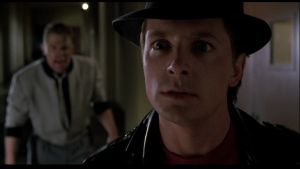This is the sixth article in the Back to the Future theme week series.

There's a dramatic principle called Chekhov's gun:
Remove everything that has no relevance to the story. If you say in the first chapter that there is a rifle hanging on the wall, in the second or third chapter it absolutely must go off. If it's not going to be fired, it shouldn't be hanging there.
The idea is to remove anything that's not going to be relevant to the story, or in other words, don't add too many red herrings.
A real life example: my very first work of IF was about a hard-boiled detective who, as I first assumed, has to carry a handgun as the genre trope dictates. The problem was that there was no actual use for the gun at any point in the story. It was just inventory filler for the sake of "realism." It wasn't until a beta tester brought the subject up when the gun had to go.
Let's take another practical example. A story features a bedroom. There you have a bed and a nightstand. On the nightstand there's a ballerina-shaped porcelain clock. As per the Chekhov's gun principle, we ask ourselves what purpose do these items have. The bed is there because it's an essential part of a bedroom; there would have to be a good reason for not having one there. The night stand is there to support the clock.
That leaves the porcelain clock. Why is it there? Does it play a part in the plot later on? Does it tell something important about its owner? Whatever its purpose, owning such a tacky thing is notable enough that it would have to be explained. It can't just spontaneously exist without a reason.
If it turns out that the clock is not a Checkhov's gun, i.e. it doesn't have a relevance to the story, then it should go. And since the only purpose of the nightstand was to provide a place to put the clock on, it shouldn't be mentioned either.
Note that, in the context of text-based narrative, not mentioning something doesn't mean that it doesn't exist in the story world. It just means that it's not significant enough to mention (or implement). Every location has tens or even hundreds of things that could be realistically expected to exist but have no relevance and therefore aren't mentioned or implemented.
The reverse Chekhov
Here's a transcript of an interview from the documentary Tales from the Future: In the Beginning... where Back to the Future writer and producer Bob Gale talks about writing the script.
We use the index card method of plotting. So we would have a big bulletin board in our office, and we would say "ok, we know, for example, Marty goes back in time." So, an index card goes up, says "Marty goes back in time." And then, towards the end "Marty goes back to the future," that's another card.
So we said ok, wouldn't it be cool if he invented rock 'n' roll. So we put up a card saying "Marty invents rock 'n' roll." Well, we need to establish that he can play rock 'n' roll. And that he wants to play rock 'n' roll. So that means that somewhere on the bulletin board before the card that says "he goes back in time": "establish Marty's desire and ability to play rock 'n' roll."
Same thing with the skateboard. If he's going to invent the skateboard, show him on a skateboard. So these pairs of index cards would come up.
In light of this technique I'd like to turn the Chekhov's gun principle around:
If a rifle goes off in the second or third chapter, in the first chapter you must say that there is one hanging on the wall.
This is perhaps even more useful than the standard Chekhov's rule, at least in the early stages when you're designing the overall plot of the story. Working backwards by taking things you want the story to feature and adding things that support that feature to earlier points in the story will add a nice dose of authenticity to the setting and characters.

 Common writing advice is to always avoid clichés, but that's too simplistic to accept as a universal rule. Clichés and sterotypes serve to support another advice: Show, don't tell.
Common writing advice is to always avoid clichés, but that's too simplistic to accept as a universal rule. Clichés and sterotypes serve to support another advice: Show, don't tell. 

